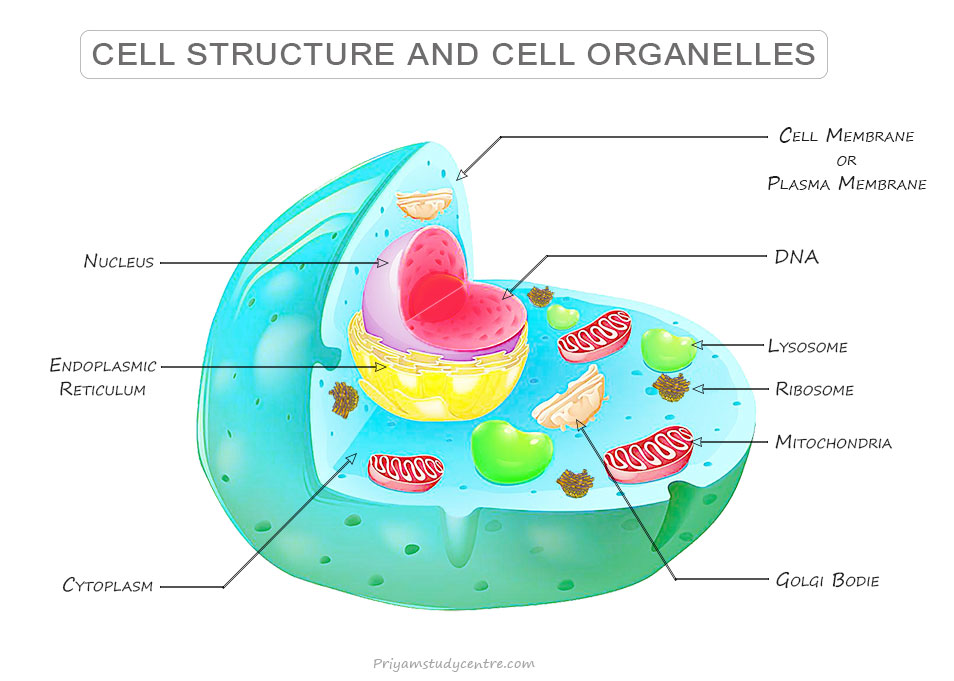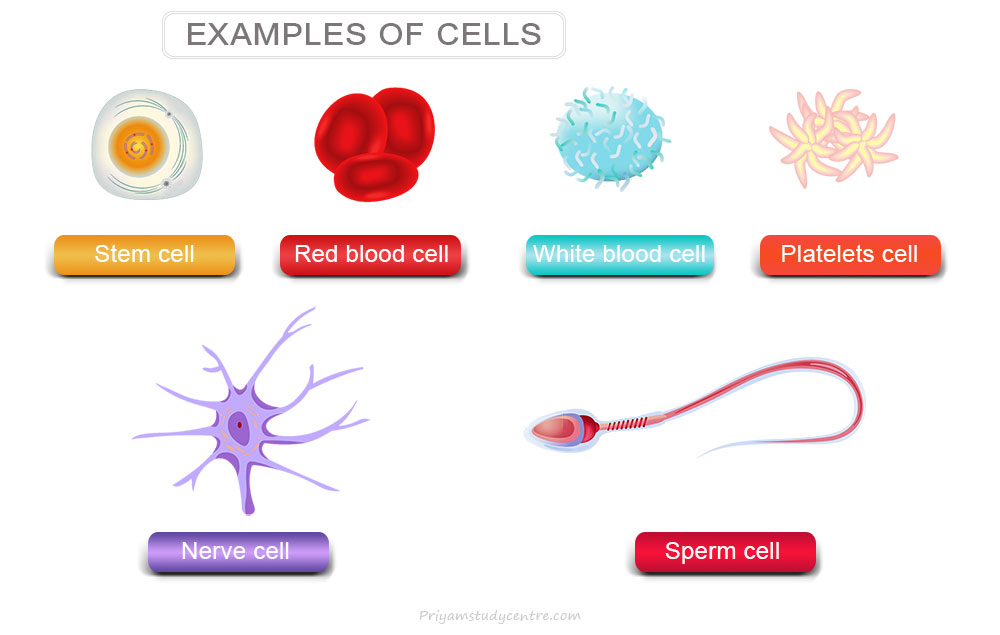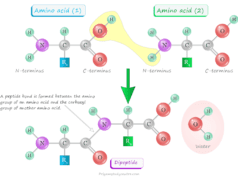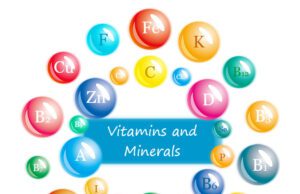What is Cell in Biology?
A Cell in biology is the structural and functional unit of life that contains fundamental molecules of living organisms. The main functions of cells and cell organelles are replication, protein synthesis, motility, and transferring genetic materials such as deoxyribonucleic acid (DNA) and ribonucleic acid (RNA). All the cells are very small in size but much larger than atoms. The cell in biology may also be regarded as the basic unit or structure of life. The term cell comes from the Latin word cellula meaning ‘small room’ and becomes the building blocks of eukaryotic cells (human, animal, and plant). Prokaryotic cells such as bacteria or yeast may also contain a single cell with a simple structure.

Discovery of Cells
Robert Hooke in 1665 observed that a thin slice of cork (comes from the bark of a tree) consists of a small box-like structure resembling honeycombs when examining it under a primitive microscope. He names these boxes cells. The basic characteristics of cells are,
- Cells can replicate independently.
- They contain heredity information of living organisms.
- Cells can perform all the life-sustaining activities on their own pathway.
- All the cells show similar chemical composition and metabolic activities.
Major Discovery of cell
| Scientist | Year | Work |
| Robert Hooke | 1665 | Discovered cells for the first time in the cork slice by a primitive microscope |
| Antonie van Leeuwenhoek | 1674 | Discovered free-living cells in pond water by his improving Microscope |
| Robert Brown | 1831 | He discovered the nucleus in the cells |
| Schleiden and Schwaan | 1838 to 1839 | They provided cell theory, which states that all living organisms (plants and animals) are composed of cells and it is the basic unit of life. |
| Purkinje | 1839 | First, introduce the term protoplasm for the fluid substance inside the cells. |
| Virchow | 1855 | Expanding cell theory suggested that all new cells of living organisms arise from pre-existing cells. |
| Knoll and Ruska | 1940 | He is understanding the complex structure of cells and their organelles by his own build electron microscope. |
Difference Between Prokaryotic and Eukaryotic Cell
In biology, the cells of living organisms may be classified into two main categories, a prokaryotic cell and a eukaryotic cell. The main differences between these types of cells are given below in the table,
| Sl No | Characteristic | Prokaryotic cell | Eukaryotic cell |
| 1 | Size | Small size and simple structure. | Large size and complex structure. |
| 2 | Cell membrane | A rigid cell wall surrounds the outer part of the cells. | A flexible plasma membrane surrounds the outer part of this cell. |
| 3 | Nucleus | Not well defined: Deoxyribonucleic acid (DNA) is found as a nucleoid, and histones are absent. | Well-defined and surrounded by a membrane, DNA associated with histones. |
| 4 | Energy metabolism | Mitochondria is absent, and enzymes of energy metabolism are bound to the membrane. | Enzymes of energy metabolism occur in mitochondria. |
| 6 | Cell division | Usually, fission and no mitosis happen. | Mitosis happens. |
| 7 | Cytoplasm | Oganells and cytoskeleton absent. | Eukaryotic cells contain organelles and the cytoskeleton. |
| 8 | Examples | Cell in bacteria | Animal and plant cells. |
Examples of Cells
Some cells such as plant and animal cells have fixed shapes while some cells such as WBCs and Amorba keep changing their shapes. Fixed cells may have various types of shapes. Some examples of human cells and their structure are given below in the picture,
Examples of such various types and shapes of cells found in the human body are:
- Fat cell (elliptical)
- Ovum (spherical)
- Smooth muscle cell (Spindle shape)
- Sperm (knobbed thread)
- RBC (discoidal)
- Nerve cell (elongated), etc
Structure and Function of Cells
In biology, each cell of a living organism has the capacity to perform some basic functions. The shape and size of cells and their organelles are related to the specific functions they perform. The most common biological functions performed by a cell or its organelles are:
- Different parts of the human body are specialized to perform different functions. For example, the heart is made to pump human blood, the stomach is made to digest food that we eat, the kidney is made for filtering urine, etc.
- Every cell possesses certain specific components known as cell organelles and they perform specific functions of life such as nutrition, respiration, clearing waste material, or forming new progeny. For example, mitochondria is an organelle providing energy to a cell.
Cell Structure
From the microscopic studies, it was clear that all cells possess three basic units or features. Due to the presence of these three features, all the activities or functions inside the cells and the interaction of a cell with its environment are possible. These three basic features are:
- Plasma membrane or cell membrane
- Cell wall
- Nucleus
- Cytoplasm
Plasma Membrane or Cell Membrane
The plasma membrane is a thin, delicate cover of a cell that separates contents inside the cell from its external environment. It contains phospholipids formed by lipids and proteins. Due to the presence of phospholipids, the plasma membrane is flexible and it transports food and other materials from the external environment to a cell.
The plasma membrane helps to maintain the shape and mechanical barrier of cells. The transport of substances through the plasma membrane is the most important function of the plasma membrane. The transport of substances across the plasma membrane may take place through diffusion and osmosis.
- Diffusion: The spontaneous movement of solid, liquid, and gaseous substances from a region to its higher concentration region is called diffusion. Carbon dioxide and other cellular waste are accommodated in higher concentrations inside the cell compared to the external environment. Therefore, these substances are easily moved out by the process of diffusion. Similarly, oxygen enters the cell when the concentration of oxygen inside the cell decreases.
- Osmosis: The movement of water (H2O) molecules through a selectively permeable membrane along the concentration gradient is called osmosis. The movement of water through the plasma membrane suggests the amount of substance inside the cells dissolve in water. Unicellular freshwater organisms and plant roots absorb water through the process of osmosis.
Cell Wall
The cell wall is a tough, non-living, freely permeable covering outside the plasma membrane found only in plant cells. It is formed by a complex substance called cellulose. It may provide the structural strength of plants.
The cell wall contains narrow pores, called pits, through which fine strands of cytoplasm or plasmodesmata are able to cross the walls. Therefore, plant cells can interact with each other through these cytoplasmic channels.
Nucleus
The nucleus is the largest organelle of cells that is surrounded by a double membrane nuclear envelope. It is the brain of a cell that has numerous pores called nuclear pores for the transfer of materials from the nucleus to the cytoplasm. It contains chromosomes that are visible during the division of cells. The nucleus is enclosed by a liquid ground substance, called nucleoplasm that contains nucleolus and chromatin material.
The nucleus plays an important role in cellular reproduction or cell division, development, transmission of heredity, and control the metabolic activities. Chromosomes contain information for the inheritance of features from parents to the next generation in the form of deoxyribonucleic acid (DNA) molecules. It also contains ribonucleic acid (RNA) that helps in protein synthesis.
In some living organisms like bacteria, the nuclear region is poorly defined because of the absence of the nuclear membrane. The nuclear region of such living organisms contains only nucleic acids and is called nucleoid. The living organisms whose cells do not contain a nuclear membrane are called prokaryotes.
Cytoplasm
The cytoplasm in biology is the large region of a cell containing fluid enclosed by a plasma membrane. It contains many specialized cell organelles that perform specific work for a cell.
Cytoplasm is a storehouse of a cell that stores vital molecules such as amino acids, glucose, vitamins, iron, etc. It helps to exchange such vital molecules between cell organelles. It is a site that is used for performing glycolysis.
The outer membrane is continuous with the membranes of the endoplasmic reticulum of a complex cell. It contains nuclear pores that permit the free passage of products synthesized in the nucleus in the surrounding cytoplasm of a cell.
Cell Organelles and Their Functions
Large and complex cells of multicellular organisms need a lot of chemical activities to support their complicated structure and biological functions. To keep these activities separated from each other, these cells used membrane-bound structures or organelles to perform specialized functions within themselves. They are the main characteristic features that separate eukaryotic cells from prokaryotic cells.
Endoplasmic Reticulum
The endoplasmic reticulum is a large network of membrane-bound tubes and sheets extended from the outer nuclear membrane to the cytoplasm of the cells. The structure of the endoplasmic reticulum is similar to that of the plasma membrane. Depending upon the nature of the endoplasmic reticulum membrane, it can be classified into two types,
- Rough Endoplasmic Reticulum: The surface of such type of endoplasmic reticulum is rough due to the presence of ribosomal particles.
- Smooth Endoplasmic Reticulum: The surface of such type of endoplasmic reticulum is rough due to the absence of ribosomal particles.
The proteins are manufactured in ribosomes of cells transported through the endoplasmic reticulum. Many other proteins and lipids synthesized by endoplasmic reticulum function as enzymes and hormones. It also functions as a detoxification of poisons and drugs.
Golgi Apparatus
Golgi apparatus are the membrane-bound fluid-filled vesicles, large spherical vacuoles, and smooth, flattened cisternae which are stacked parallel to each other. The Golgi apparatus and smooth endoplasmic reticulum constitute another portion of a complex cellular system. The materials that are synthesized near the endoplasmic reticulum can be packaged and dispatched through the Golgi apparatus.
Golgi apparatus can involved in various cellular functions. These cellular functions are:
- Storing, modifying, and packing the products
- Formation of lysosomes
- Formation of complex sugars from simple sugars in some cases
- Involving in the synthesis of cell wall and plasma membrane
Lysosomes
Lysosomes are a kind of waste disposal system of cells that contain membrane-bound sacs filled with digestive enzymes. When the cell gets damaged or during the disturbance of cellular metabolism, lysosomes of cells may burst and digestive enzymes can digest them. Therefore, in biology lysosomes are also called the suicidal bags of a cell.
Mitochondria
Mitochondria also called the “powerhouses of the cell”, were first discovered in 1857 by physiologist Albert von Kölliker. It is a double-bounded membrane organelle where the outer membrane is very porous while the inner membrane is deeply folded into finger-like projections called cristae. It creates a large surface area for ATP-generating chemical reactions.
The space between the outer and inner membrane in mitochondria is called intermembranous space. Mitochondria is the largest self-replicating (semiautonomous) organelle in animal cells.
Mitochondria is the powerhouse of the cell that generates energy for various activities of a cell. It contains sites for cellular respiration and releases energy in the form of adenosine triphosphate (ATP). ATP molecules can be down when our body requires energy for various metabolic activities. It also provides intermediates for the synthesis of various chemicals like fatty acids, steroids, amino acids, etc.
Plastids
Plastids are organelles that are found only in plant cells. The external structure of plastids is similar to that of mitochondria. They are also double-layer structures containing their own DNA and ribosome. Chloroplasts, leucoplasts, and chromoplasts are three types of plastids found only in plant cells.
- Chloroplasts: These are the plastids containing chlorophyll (a green pigment) in plants where photosynthesis occurs.
- Leucoplasts: These are white or colourless plastids that store biomolecules such as starch (amyloplasts), oils (elaioplasts), and protein granules (aleuroplasts).
- Chromoplasts: These are coloured plastids that are rich in carotenoid pigments and impart colour to flowers and fruits.
Vacuoles
Vacuoles are storage sacs for solid and liquid contents for animal and plant cells. In animal cells, they are small in size while in plant cells they are large. They are bounded by the membrane is called the tonoplast. The main functions of vacuoles are:
- They provide turgidity and rigidity of cells in plants.
- Vacuoles store many organic substances such as amino acids, sugars, proteins, and organic compounds.
- Amoebas can store consumed food items in their vacuoles.
- Vacuoles also play an important role in expelling excess water and some other wastes from a cell of unimolecular living organisms.
Frequently Asked Questions
What is Cell?
The cell is the structural and functional unit of life that can control all biological activities of living organisms. The cells of the living kingdom may be divided into two categories, prokaryotes, and eukaryotes.
In biology, a prokaryotic cell does not contain a well-defined nucleus and possesses a relatively simple structure while a eukaryotic cell contains a well-defined nucleus and is more complex in its structure and function. Various bacteria contain prokaryotic cells while higher organisms such as plants and animals contain eukaryotic cells.
How Cell was Discovered?
A cell in biology was discovered in 1665 when Robert Hooke observed a cork slice with the help of a primitive microscope. The structure of the observed cork slice resembles a honeycomb consisting of many small components or boxes. Therefore, Robert Hooke called these boxes cells.
What is Nucleus?
The nucleus is the largest cellular organelle of a cell that is surrounded by a double membrane nuclear envelope. In a certain interval, the two nuclear membranes have nuclear pores that permit free transfer of the products synthesized in the nucleus into the surrounding cytoplasm.
The eukaryotic nucleus contains DNA that bears the genetic information of living organisms and associates with basic protein histones to form nucleosomes. The assembly of nucleosomes constitutes fibers of chromosomes. Human beings contain 46 chromosomes completely packed with the nucleus.
The nucleus of the eukaryotic cell contains a dense body known as nucleous. The nucleous of eukaryotic cells is rich in RNA, particularly the ribosomal RNA which enters the cytosol through nuclear pores.
When Red Blood Cells are Low?
A low red blood cell count or anemia is the most prevalent nutritional disorder that occurs due to various possible health conditions. It mostly occurs in growing children, adolescent girls, pregnant women, and lactating women.
- When the diet you can take does not contain enough iron, vitamin B12, or folate can increase the risk of iron deficiency anemia.
- A blood loss due to injury or illness can cause low red blood cells or anemia.
- Chronic health conditions such as chronic kidney disease and blood cancer also can cause anemia.
- Heavy menstrual periods in adolescent girls can also increase the risk of anemia.
- Pregnant women who cannot take multivitamins with iron and folic acid or lactating women who suffer from small absorption nutrients can increase the risk of a low red blood cell count or anemia.








